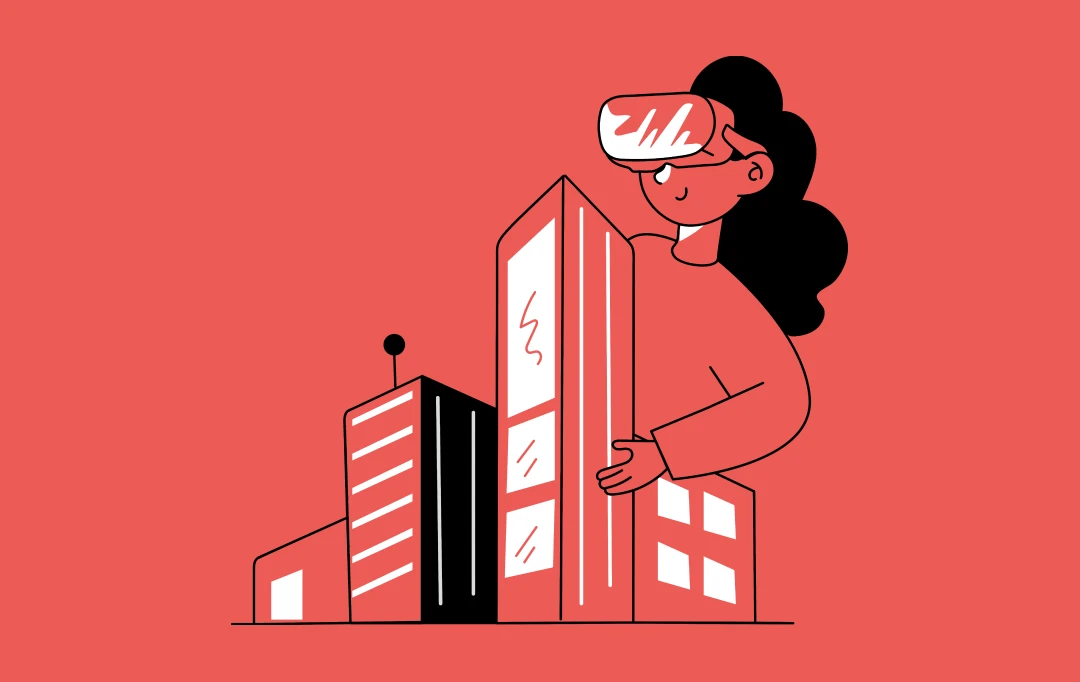- An Outlook of The Current AR/VR Market Scenario
- What are the Future Trends in AR and VR
- 1. Introduction of AI in AR/VR space
- 2. Rise in the number of AR avatars
- 3. Gearing up vehicles with the power of AR
- 4. 5G will speed up AR/VR evolution
- 5. Advent of WebAR
- 6. Advancement in AR/VR displays
- 7. Remote assistance via virtual and augmented reality
- 8. Use of XR in healthcare as a medical device
- 9. Emergence of AR-based indoor navigation
- 10. Establishment of Augmented and virtual reality in education domain
- What is the Future of Augmented Reality and Virtual Reality?
- How to Prepare For The AR/VR Influenced Future?
- Frequently asked questions (FAQs)
Augmented and Virtual reality have brought impactful impressions on the world last year around the globe since its inception. These technologies not only touched the hearts of the smartphone users, but also caught the attention of emerging and established brands, making entrepreneurs and marketers look ahead into investing in AR VR app development.
However, this was just the beginning.
In the past years the technology has brought a transformative effect on the business world. The AR VR technology trends in the coming years will make sure that every businessperson to consult the experts and enter this domain to get a bigger slice of the forecasted market size of USD $1,274.4 billion in 2030.
The projected AR and VR technology trends, which I will reveal in this article, are expected to totally change the way we connect with each other and take us a step closer to the ‘digitally augmented’ space.
But before we jump to that part, let’s take a look at how far AR/VR has traveled till date, ever since Google VR Tilt Brush was launched. Simply put, get familiar with the present state of Augmented and Virtual technology.
An Outlook of The Current AR/VR Market Scenario
Virtual reality, which was correlated with hardware in the beginning, has slowly and gradually entered the software industry. It has become the largest player in the gaming and entertainment sector, as well as captured the attention of companies with different industrial applications.
Whereas, when talking about Augmented reality, the technology has made everyone interested in exploring its benefits for business and building a better future ahead.
As per IDC predictions, the AR/VR market was enjoying about 60% of the total world spending in 2018. But, it is expected to hit 85% of the total world spending by the end of 2021, with retail, transportation, manufacturing and public sectors on the top of the chart.
According to Markets and Markets, The VR market is projected to grow from USD 6.1 billion in 2020 to USD 20.9 billion by 2025; it is expected to grow at a CAGR of 27.9% from 2020 to 2025.
On a geographical basis, North America is found to be the region which invested heavily in the AR/VR market in the past 12 months and is forecasted to witness fastest growth in the next 5 years.

However, they are expected to have a bigger market share by the year 2025, with a better focus on using the technologies for scaling their processes efficiently. Likewise, SMEs are expected to grow their involvement in the AR/VR market with a CAGR of 66.40% during the period 2018-2025.
Now, as you’ve a glimpse of the current state of the AR and VR market size and a hint of the future, let’s plunge into the trends and technologies that will boost expansion of this market.
What are the Future Trends in AR and VR
1. Introduction of AI in AR/VR space
Artificial intelligence, Augmented reality, and Virtual reality have entered the business world long back and proved their potential individually.
But, in the future, VR AR developers and AR VR development company leaders will look forward to discussing the potential of their collaboration. They will look into getting a clear idea of how advanced machine learning algorithms and other AI methodologies can aid computers and other devices in visualizing things and understanding them effectively.
This will further lead to the emergence of highly interactive workspaces and improved image recognition facilities.
2. Rise in the number of AR avatars
In the past few years, a significant rise has been experienced in the popularity of virtual celebrities like Activ8’s Kizuna AI and Brud’s Lil Miquela. These fictional characters have appealed to consumers and have become their virtual influencer. A result of which is that their market potential is expected to increase in the coming years.
Business leaders and marketers are expected to incorporate these avatars into their business processes not solely for attracting users, but helping them in navigation inside/outside the physical store, and adding a tint of beauty to their overall experience, and more.

3. Gearing up vehicles with the power of AR
Autonomous vehicles are becoming more and more popular in the world. People are curiously waiting to get into these self-driving cars. But, what’s amazing the automobile manufacturers is the integration of Augmented reality into these vehicles in the near future.
In the coming time, various automotive industry leaders will embrace the idea of using these two top technology trends to redefine the way people move and travel in the form of voice assistants, in-car AR, and more.
4. 5G will speed up AR/VR evolution
As already mentioned in our blog on the impact of 5G on mobile apps, the technology will bring an impactful difference in the way we embrace AR/VR.
5G, by offering a super-fast mobile network, will increase the pace of data transfer to the cloud, its processing, and formation of a virtual image that will later deliver an enhanced virtual experience to the consumers.
What’s more, the technology will boost the experience level even in low-bandwidth, low-powered environments, making it possible to enjoy better augmented experience with cheaper headsets and devices too.
[Also Read: 10 Use Cases Of How AR Is Changing The Way Consumers Interact With Banking And Financial Services]
5. Advent of WebAR
Till yesterday, the AR experience was limited to mobile devices. One is supposed to download and install the mobile application to get into the augmented world. But now, the WebAR has come into existence.
As depicted from the name, this will facilitate users to interact with augmented reality in the web space. It will enable them to get exposure to AR on Google Chrome, Mozilla Firefox, or other such browsers regardless of which device they run upon, resulting in lower barriers to its usage and higher overall experience.
Related Article: Deciphering the Augmented Reality App Development Costs, Features, and Process
6. Advancement in AR/VR displays
Another AR and VR market trend that will rise and grow is advancements in displays.
This year, the display of the AR/VR headsets will be magnified to ensure that the immense of high-power content displays on the screen without getting blurred or putting strain on your eyes.
[Also Read: VisionOS app development – Empowering businesses for the era of spatial computing]
7. Remote assistance via virtual and augmented reality
AR VR trends will put forth better opportunities of remote assistance and collaboration.
The technologies will enable technicians to see on site situations in real-time via their mobile phones or laptop. They will be able to assess everything and send the files (images, videos, or PDFs) with proper comments/notes to remote locations which will remain locked on the shared scene.
[Also Read: How AR/VR in Used in Energy and Utilities Sector: Top Benefits and Use Cases]
To get a clear idea of the use of AR/VR apps for remote assistance, check out the video below:
8. Use of XR in healthcare as a medical device
AR, MR, and VR are revamping the healthcare industry by fulfilling different purposes independently.
With the merge of these three technologies, healthcare and medical practitioners are able to ‘swipe’ between these three technologies within the same application. This facilitates professionals with higher efficiency, productivity, as well as enables them to relish the perks of different use cases at the same time.

To make use of this technology, the healthcare organizations will have to establish XR platforms as a medical device. And this won’t be as easy as it seems.
Thus, to overcome various strategies and challenges that hinder the path towards a medical extended reality, it is important to have a support of a medical app development services to achieve fruitful outcomes.
9. Emergence of AR-based indoor navigation
One of the emerging trends and the future scope of AR and VR is use of technology for indoor navigation.
Just like GPS-built in software and maps direct us towards a shop, hospital, or other place from outside, the augmented reality powered navigation systems will assist people indoors. They will instruct them the path towards any particular product, software, or location in an engaging and effortless way; giving them an optimal experience without relying on others.

10. Establishment of Augmented and virtual reality in education domain
While virtual and augmented reality will continue to blend into different industries and business processes like gaming, shopping, and entertainment, the one arena that will experience remarkable growth in the coming years is Education.
The immersive nature of virtual reality technology will help teachers in engaging students with learning material in various new and exciting ways. It will improve the chances of teaching distance learners in VR classrooms; preventing them from missing out the benefits of learning in a collaborative environment.
Whereas, augmented reality in education will add flexibility to the on-the-job learning experience. It will offer them an opportunity to get access to the information required in real-time; enabling them to polish their skills and do their job simultaneously.
Now, as you know what the popular virtual reality and augmented reality trends are for upcoming years, Let’s now head on the most expected question, i.e. how will AR and VR transform the future? What is the future of AR and VR?
Also Read: AR in Retail – How Retailers are Revolutionizing Shopping Experiences
What is the Future of Augmented Reality and Virtual Reality?
The AR/VR gadgets of the future will give customized, accessible, and well-designed experiences. As these components grab hold, a platform shift is undeniable. With this constant pace, in three years we will see new AR glasses with LTE abilities that will turn into an option to the smartphone.
With improved immersive innovation and AR capacities, the structure factor of our number one consumer electronics will change and we’ll never look back. In the following years, we might be utilizing AR technology to check our messages and smart glasses to look through Instagram.
Also check out, The applications and benefits of VR and wearables in the healthcare industry and; Metaverse use cases and benefits for modern businesses
The future for AR VR is that businesses are gearing up for the change and are looking for top AR VR companies in USA to grow their business.Industries like retail, healthcare, and entertainment are already leveraging the power of AR VR to enhance customer engagement and streamline operations. Even AR VR in food and beverages is gaining traction, offering immersive dining experiences and optimizing kitchen workflows for better efficiency.
So, taking the same into consideration, let’s wrap up this article determining how to gain fruitful results from these AR and virtual reality trends.
Also read: Spatial Computing In The Enterprise – Embracing The Next Frontier Of Digital Innovation
How to Prepare For The AR/VR Influenced Future?
As we have discussed in this article, virtual and augmented reality are predicted to bring a momentous change in the business world. In such a scenario, having awareness of the AR/VR trends and top virtual reality companies perspective towards this is not enough. To prepare for the near future in a professional and profitable manner, it is recommended that you contact the AR VR app development company about the possibilities of introducing their raw power into your business.
Frequently asked questions (FAQs)
Q. Is augmented reality and artificial intelligence the same thing?
No, they are different. While Augmented reality (AR) refers to the technology that embeds virtual 3D elements into the real world, Artificial intelligence (AI) is the technology that enables machines to think, react, and respond like humans without their interventions.
Q. How AI-powered augmented reality transforms digital experience?
AI, when combined with augmented reality, will make it easier to deliver immersive experience quickly and efficiently than ever before. The collaborative technology will not solely sense the position of the customer, but also his expressions and other features which will define the results of emotional intelligence and later, help companies deliver the experience that pleases customers.
Q. How Extended reality (XR) technology will accelerate healthcare training?
Extended reality (XR) will enable practitioners to swipe between AR, VR, and MR elements at any given time. This will let them get access to the required information and practice their skills in real environments without harming any real species. For example, with the help of XR technology, the medical students will be allowed to practice delivering a baby in the back of a cab with limited medical equipment.
Q. Is the future of Virtual Reality and AR relying on 5G?
Yes. 5G technology will uplift the potential and use cases of AR/VR in the marketplace; resulting in a brighter future for the two.
Q. How is VR training helpful for a business?
The benefits of VR training are immense, which can lead from improved customer service, reduced onboarding time, and increased operational efficiency to reduced employee turnover and decreased incident cost. Walmart, KFC, ExxonMobil are some of the popular companies that have used VR training in their companies.


- In just 2 mins you will get a response
- Your idea is 100% protected by our Non Disclosure Agreement.

10 Use Cases and Examples of How Extended Reality (XR) is Driving Innovation Across Industries
Imagine a factory where engineers diagnose machinery issues using 3D holograms or a hospital where surgeons rehearse complex procedures in a fully immersive virtual space before operating on a real patient. These scenarios are not distant possibilities - they are happening today and are powered by Extended Reality - XR use cases. As a convergence…

13 Use Cases and Examples of How Adaptive AI is Transforming Industries
Slashing downtime, boosting margins, automating workflow, and stealing your market share. You must be thinking that these buzzwords are Silicon Valley’s hype. No, these are the silent revolutions hitting Main Street industries. From manufacturing deploying demand forecasting to controlling production lines, healthcare tailoring predictive care and driving better outcomes. The success mantra—these industries are quietly…

AR/VR in Construction - 10 Use Cases of How Augmented and Virtual Reality is Shaping the Industry
The use of extended reality technologies is one of the growing trends in the expanding domain of construction technology. As the sector gradually adopts more sophisticated practices, virtual and augmented reality in construction have emerged as revolutionary solutions. With compelling advantages like planning, marketing, and training, AR/VR technologies are transforming the face of construction. Prescient…
















